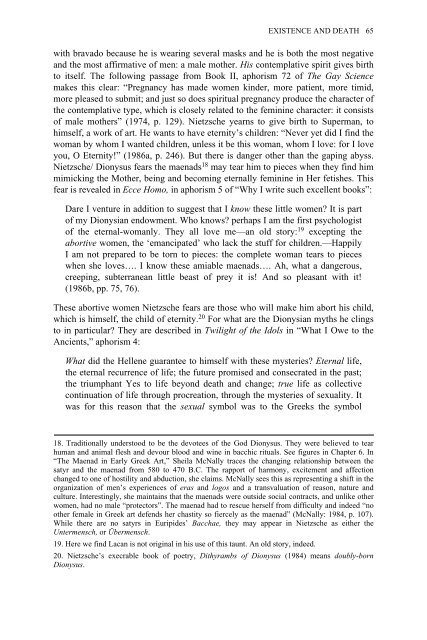Nothing Mat(t)ers: A Feminist Critique of Postmodernism
Nothing Mat(t)ers: A Feminist Critique of Postmodernism
Nothing Mat(t)ers: A Feminist Critique of Postmodernism
You also want an ePaper? Increase the reach of your titles
YUMPU automatically turns print PDFs into web optimized ePapers that Google loves.
EXISTENCE AND DEATH 65<br />
with bravado because he is wearing several masks and he is both the most negative<br />
and the most affirmative <strong>of</strong> men: a male mother. His contemplative spirit gives birth<br />
to itself. The following passage from Book II, aphorism 72 <strong>of</strong> The Gay Science<br />
makes this clear: “Pregnancy has made women kinder, more patient, more timid,<br />
more pleased to submit; and just so does spiritual pregnancy produce the character <strong>of</strong><br />
the contemplative type, which is closely related to the feminine character: it consists<br />
<strong>of</strong> male moth<strong>ers</strong>” (1974, p. 129). Nietzsche yearns to give birth to Superman, to<br />
himself, a work <strong>of</strong> art. He wants to have eternity’s children: “Never yet did I find the<br />
woman by whom I wanted children, unless it be this woman, whom I love: for I love<br />
you, O Eternity!” (1986a, p. 246). But there is danger other than the gaping abyss.<br />
Nietzsche/ Dionysus fears the maenads 18 may tear him to pieces when they find him<br />
mimicking the Mother, being and becoming eternally feminine in Her fetishes. This<br />
fear is revealed in Ecce Homo, in aphorism 5 <strong>of</strong> “Why I write such excellent books”:<br />
Dare I venture in addition to suggest that I know these little women It is part<br />
<strong>of</strong> my Dionysian endowment. Who knows perhaps I am the first psychologist<br />
<strong>of</strong> the eternal-womanly. They all love me—an old story: 19 excepting the<br />
abortive women, the ‘emancipated’ who lack the stuff for children.—Happily<br />
I am not prepared to be torn to pieces: the complete woman tears to pieces<br />
when she loves…. I know these amiable maenads…. Ah, what a dangerous,<br />
creeping, subterranean little beast <strong>of</strong> prey it is! And so pleasant with it!<br />
(1986b, pp. 75, 76).<br />
These abortive women Nietzsche fears are those who will make him abort his child,<br />
which is himself, the child <strong>of</strong> eternity. 20 For what are the Dionysian myths he clings<br />
to in particular They are described in Twilight <strong>of</strong> the Idols in “What I Owe to the<br />
Ancients,” aphorism 4:<br />
What did the Hellene guarantee to himself with these mysteries Eternal life,<br />
the eternal recurrence <strong>of</strong> life; the future promised and consecrated in the past;<br />
the triumphant Yes to life beyond death and change; true life as collective<br />
continuation <strong>of</strong> life through procreation, through the mysteries <strong>of</strong> sexuality. It<br />
was for this reason that the sexual symbol was to the Greeks the symbol<br />
18. Traditionally und<strong>ers</strong>tood to be the devotees <strong>of</strong> the God Dionysus. They were believed to tear<br />
human and animal flesh and devour blood and wine in bacchic rituals. See figures in Chapter 6. In<br />
“The Maenad in Early Greek Art,” Sheila McNally traces the changing relationship between the<br />
satyr and the maenad from 580 to 470 B.C. The rapport <strong>of</strong> harmony, excitement and affection<br />
changed to one <strong>of</strong> hostility and abduction, she claims. McNally sees this as representing a shift in the<br />
organization <strong>of</strong> men’s experiences <strong>of</strong> eras and logos and a transvaluation <strong>of</strong> reason, nature and<br />
culture. Interestingly, she maintains that the maenads were outside social contracts, and unlike other<br />
women, had no male “protectors”. The maenad had to rescue h<strong>ers</strong>elf from difficulty and indeed “no<br />
other female in Greek art defends her chastity so fiercely as the maenad” (McNally: 1984, p. 107).<br />
While there are no satyrs in Euripides’ Bacchae, they may appear in Nietzsche as either the<br />
Untermensch, or Übermensch.<br />
19. Here we find Lacan is not original in his use <strong>of</strong> this taunt. An old story, indeed.<br />
20. Nietzsche’s execrable book <strong>of</strong> poetry, Dithyrambs <strong>of</strong> Dionysus (1984) means doubly-born<br />
Dionysus.

















